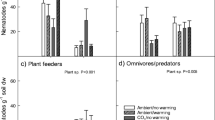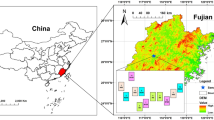Abstract
Soil microfauna in 0- to 10-cm soil under grazed pasture on a sand (Mollic Psammaquent) was assessed quarterly in free air CO2 enrichment (FACE) rings that were at either ambient CO2 or had been exposed to 475 μl l−1 CO2 for 4–5 years. There were significant increases in nematode (1.5×) and rotifer (4.1×) abundance in soils subjected to elevated CO2. Ten nematode taxa were significantly more abundant under elevated CO2. The greatest increase was 4.3× in root-feeding Longidorus; three other root-feeders showed no increase in population densities at elevated CO2. Bacterial-feeding Cervidellus was the only nematode with a significant decrease (0.4×). The abundance of all nematode feeding groups increased significantly in soils subjected to elevated CO2. The relative increases in abundance of feeding groups (bacterial-feeders 1.3×, root-feeders 1.3×, plant-associated 1.5×, fungal-feeders 1.6×, omnivores 2.0×, predators 2.1×) suggest marked increases in fluxes through microbial-feeding nematodes and a multitrophic response among the soil biota to the increase in atmospheric CO2 above ambient. Data from the site suggest soil microbial biomass C and N pools were unchanged over the sampling period. Of eight nematode indices only total maturity index increased (2.9 to 3.2), reflecting the increased proportion of the large Longidorus. Further work on microbial-microfaunal interactions and their micro-scale relation to roots is needed to better understand the impact of increasing atmospheric CO2 on soil processes.


Similar content being viewed by others
References
Arnone JA, Kestenholz C (1997) Root competition and elevated CO2: effects on seedling growth in Linum usitatissimum populations and Linum-Silene cretica mixtures. Funct Ecol 11:209–214
Ball AS (1997) Microbial decomposition at elevated CO2 levels. Global Change Biol 3:379–386
Blaxter ML, De Ley P, Garey JR, Liu LX, Scheldeman P, Vierstraete A, Vanfleteren JR, Mackey LY, Dorris M, Frisse LM, Vida JT, Thomas WK (1998) A molecular evolutionary framework for the phylum Nematoda. Nature 92:71–75
Buse A, Good JEG, Dury S, Perrins CM (1998) Effects of elevated temperature and carbon dioxide on the nutritional quality of leaves of oak (Quercus robur L.) as food for the winter moth (Operophtera brumata L.). Funct Ecol 12:742–749
Canadell JG, Pataki D (2002) New advances in carbon cycle research. Trends Ecol Evol 17:156–158
Cardon ZG, Hungate BA, Cambardella CA, Chapin FS, Field CB, Holland EA, Mooney HA (2001) Contrasting effects of elevated CO2 on old and new soil carbon pools. Soil Biol Biochem 33:365–373
Coûteaux M-M, Mousseau M, Célérier M-L, Bottner P (1991) Increased atmospheric CO2 and litter quality: decomposition of sweet chestnut leaf litter with animal food webs of different complexities. Oikos 61:54–64
Didden WAM (1993) Ecology of terrestrial Enchytraeidae. Pedobiologia 37:2–29
Drennan PM, Nobel PS (1998) Root growth dependence on soil temperature for Opuntia ficus-indica: influences of air temperature and a doubled CO2 concentration. Funct Ecol 12:959–964
Edwards GR, Clark H, Newton PCD (2001) The effects of elevated CO2 on seed production and seedling recruitment in a sheep-grazed pasture. Oecologia 127:383–394
Griffin KL, Seemann JR (1996) Plants, CO2 and photosynthesis in the 21st century. Chem Biol 3:245–254
Griffiths BS, Robertson WM (1984) Morphological and histochemical changes occurring during the life-span of root-tip galls on Lolium perenne induced by Longidorus elongatus. J Nematol 16:223–229
Hoeksema JD, Lussenhop J, Teeri JA (2000) Soil nematodes indicate food web response to elevated atmospheric CO2. Pedobiologia 44:725–735
Hungate BA, Jaeger CH, Gamara G, Chapin FS, Field CB (2000) Soil microbiota in two annual grasslands: responses to elevated atmospheric CO2. Oecologia 124:598–598
Hunt DJ (1993) Aphelenchida, Longidoridae and Trichodoridae: their systematics and bionomics. CAB International, Wallingford
IPCC (2001) The intergovernmental panel on climate change (IPCC) third assessment report. Cambridge University Press, Cambridge
Klironomos JN, Rillig MC, Allen MF (1996) Below-ground microbial and microfaunal responses to Artemisia tridentata grown under elevated atmospheric CO2. Funct Ecol 10:527–534
Marissink M, Pettersson R, Sindhøj E (2002) Above-ground production under elevated carbon dioxide in a Swedish semi-natural grassland. Agric Ecosyst Environ 93:107–120
Mooney HA (1991) Biological response to climate change—an agenda for research. Ecol Appl 1:112–117
Mulk MM, Coomans A (1979) Three new Alaimus-species (Nematoda: Alaimidae) from Mount Kenya. Nematologica 25:445–457
Newton P, Clark H, Edwards GR (2001) CO2 enrichment of a permanent grassland grazed by sheep using FACE technology. In: Shimizu H (ed) Carbon dioxide and vegetation: advanced international approaches for absorption of CO2 and responses to CO2. Centre for Global Environmental Research, Tsukuba, pp 97–105
Parshotam A, Saggar S, Tate K, Parfitt R (2001) Modelling organic matter dynamics in New Zealand soils. Environ Int 27:111–119
Robertson WM, Trudgill DL, Griffiths BS (1984) Feeding of Longidorus elongatus and L. leptocephalus on root-tip galls of perennial ryegrass (Lolium perenne). Nematologica 30:222–229
Ross DJ, Scott NA, Tate KR, Rodda NJ, Townsend JA (2001) Root effects on soil carbon and nitrogen cycling in a Pinus radiata D. Don plantation on a coastal sand. Aust J Soil Res 39:1027–1039
Ross DJ, Tate KR, Newton PCD, Clark H. (2002) Decomposability of C3 and C4 grass litter sampled under different concentrations of atmospheric carbon dioxide at a natural CO2 spring. Plant Soil 240:275–286
Seinhorst JW, Kozłowska J (1979) Longidorus elongatus and Tylenchorhynchus dubius on Lolium perenne. Nematologica 25:314–321
Stockdill SMJ (1982) Effects of introduced earthworms on the productivity of New Zealand pastures. Pedobiologia 24:29–35
Suter D, Frehner M, Fischer BU, Nosberger J, Luscher A (2002) Elevated CO2 increases carbon allocation to the roots of Lolium perenne under free-air CO2 enrichment but not in a controlled environment. New Phytol 154:65–75
Thomas PR (1969) Crop and weed plants compared as hosts of viruliferous Longidorus elongatus (de Man). Plant Pathol 18:23–28
Wardle DA (2002) Communities and ecosystems: linking the aboveground and belowground components. Princeton University Press, Princeton
Wardle DA, Barker GM, Yeates GW, Bonner KI, Ghani A (2001) Introduced browsing mammals in natural New Zealand forests: aboveground and belowground consequences. Ecol Monogr 71:587–614
Wilsey BJ (2001) Effects of elevated CO2 on the response of Phleum pratense and Poa pratensis to aboveground defoliation and root-feeding nematodes. Int J Plant Sci 162:1275–1282
Yeates GW (1978) Populations of nematode genera in soils under pasture. I. Seasonal dynamics in dryland and irrigated pasture on a southern yellow-grey earth. N Z J Agric Res 21:321–330
Yeates GW (1981) Nematode populations in relation to soil environmental factors: a review. Pedobiologia 22:312–338
Yeates GW (2003) Nematodes as soil indicators: functional and biodiversity aspects. Biol Fertil Soils 37:199–210
Yeates GW, Bongers T (1999) Nematode diversity in agroecosystems. Agric Ecosyst Environ 74:113–135
Yeates GW, Orchard VA (1993) Response of pasture soil faunal populations and decomposition processes to elevated carbon dioxide and temperature—a climate chamber experiment. Australas Conf Grassl Invert Ecol 6:148–154
Yeates GW, Bongers T, de Goede RGM, Freckman DW, Georgieva SS (1993a) Feeding habits in soil nematode families and genera—an outline for soil ecologists. J Nematol 25:315–331
Yeates GW, Wardle DA, Watson RN (1993b) Relationships between nematodes, soil microbial biomass and weed management strategies in maize and asparagus cropping systems. Soil Biol Biochem 25:869–876
Yeates GW, Tate KR, Newton PCD (1997) Response of the fauna of a grassland soil to doubling of atmospheric carbon dioxide level. Biol Fertil Soils 25:307–315
Yeates GW, Newton PCD, Ross DJ (1999a) Response of soil nematode fauna to naturally elevated CO2 levels influenced by soil pattern. Nematology 1:285–293
Yeates GW, Saggar S, Hedley CB, Mercer CF (1999b) Increase in 14C-carbon translocation to the soil microbial biomass when five plant-parasitic nematode infect roots of white clover. Nematology 1:295–300
Yeates GW, Newton PCD, Allard V (2003) Elevated carbon dioxide has marked effect on soil microfauna under grazed pasture on sand. In: Bardgett RD, Hopkins DW, Usher MB (eds) Biological diversity and function in soils (programme and abstracts). British Ecological Society, Lancaster, pp 30
Acknowledgements
This work, and the maintenance of the FACE site, has largely been funded by the N.Z. Foundation for Research, Science and Technology. We are grateful to Harry Clark and others who have managed the FACE facility. Vincent Allard assessed root turnover. Greg Arnold carried out the statistical analyses. Pascal Niklaus and the referees provided valuable comments on the manuscript.
Author information
Authors and Affiliations
Corresponding author
Rights and permissions
About this article
Cite this article
Yeates, G.W., Newton, P.C.D. & Ross, D.J. Significant changes in soil microfauna in grazed pasture under elevated carbon dioxide. Biol Fertil Soils 38, 319–326 (2003). https://doi.org/10.1007/s00374-003-0659-5
Received:
Accepted:
Published:
Issue Date:
DOI: https://doi.org/10.1007/s00374-003-0659-5




